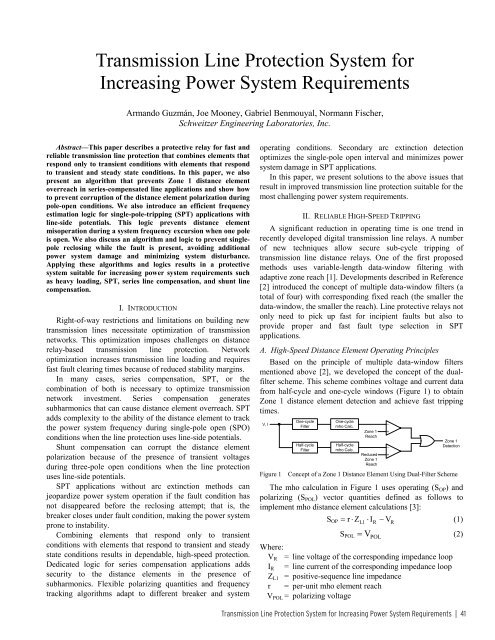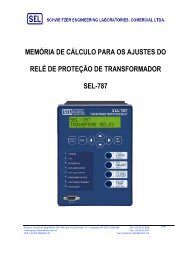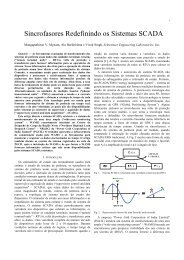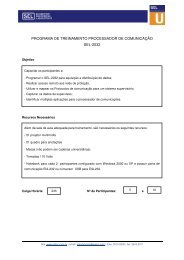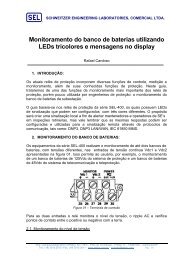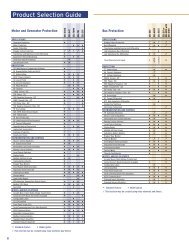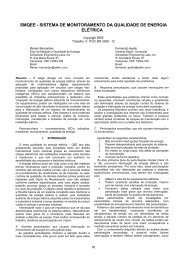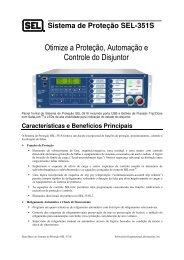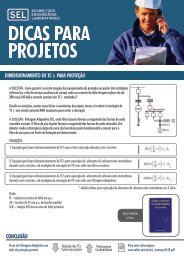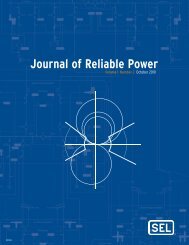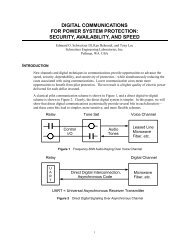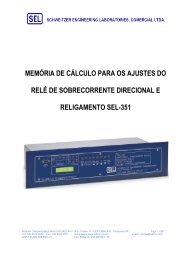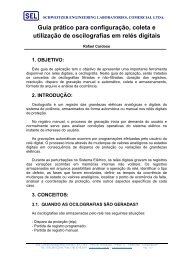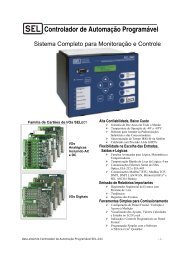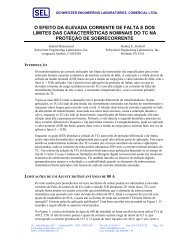Journal of Reliable Power - SEL
Journal of Reliable Power - SEL
Journal of Reliable Power - SEL
You also want an ePaper? Increase the reach of your titles
YUMPU automatically turns print PDFs into web optimized ePapers that Google loves.
Transmission Line Protection System for<br />
Increasing <strong>Power</strong> System Requirements<br />
Armando Guzmán, Joe Mooney, Gabriel Benmouyal, Normann Fischer,<br />
Schweitzer Engineering Laboratories, Inc.<br />
Abstract—This paper describes a protective relay for fast and<br />
reliable transmission line protection that combines elements that<br />
respond only to transient conditions with elements that respond<br />
to transient and steady state conditions. In this paper, we also<br />
present an algorithm that prevents Zone 1 distance element<br />
overreach in series-compensated line applications and show how<br />
to prevent corruption <strong>of</strong> the distance element polarization during<br />
pole-open conditions. We also introduce an efficient frequency<br />
estimation logic for single-pole-tripping (SPT) applications with<br />
line-side potentials. This logic prevents distance element<br />
misoperation during a system frequency excursion when one pole<br />
is open. We also discuss an algorithm and logic to prevent singlepole<br />
reclosing while the fault is present, avoiding additional<br />
power system damage and minimizing system disturbance.<br />
Applying these algorithms and logics results in a protective<br />
system suitable for increasing power system requirements such<br />
as heavy loading, SPT, series line compensation, and shunt line<br />
compensation.<br />
I. INTRODUCTION<br />
Right-<strong>of</strong>-way restrictions and limitations on building new<br />
transmission lines necessitate optimization <strong>of</strong> transmission<br />
networks. This optimization imposes challenges on distance<br />
relay-based transmission line protection. Network<br />
optimization increases transmission line loading and requires<br />
fast fault clearing times because <strong>of</strong> reduced stability margins.<br />
In many cases, series compensation, SPT, or the<br />
combination <strong>of</strong> both is necessary to optimize transmission<br />
network investment. Series compensation generates<br />
subharmonics that can cause distance element overreach. SPT<br />
adds complexity to the ability <strong>of</strong> the distance element to track<br />
the power system frequency during single-pole open (SPO)<br />
conditions when the line protection uses line-side potentials.<br />
Shunt compensation can corrupt the distance element<br />
polarization because <strong>of</strong> the presence <strong>of</strong> transient voltages<br />
during three-pole open conditions when the line protection<br />
uses line-side potentials.<br />
SPT applications without arc extinction methods can<br />
jeopardize power system operation if the fault condition has<br />
not disappeared before the reclosing attempt; that is, the<br />
breaker closes under fault condition, making the power system<br />
prone to instability.<br />
Combining elements that respond only to transient<br />
conditions with elements that respond to transient and steady<br />
state conditions results in dependable, high-speed protection.<br />
Dedicated logic for series compensation applications adds<br />
security to the distance elements in the presence <strong>of</strong><br />
subharmonics. Flexible polarizing quantities and frequency<br />
tracking algorithms adapt to different breaker and system<br />
operating conditions. Secondary arc extinction detection<br />
optimizes the single-pole open interval and minimizes power<br />
system damage in SPT applications.<br />
In this paper, we present solutions to the above issues that<br />
result in improved transmission line protection suitable for the<br />
most challenging power system requirements.<br />
II. RELIABLE HIGH-SPEED TRIPPING<br />
A significant reduction in operating time is one trend in<br />
recently developed digital transmission line relays. A number<br />
<strong>of</strong> new techniques allow secure sub-cycle tripping <strong>of</strong><br />
transmission line distance relays. One <strong>of</strong> the first proposed<br />
methods uses variable-length data-window filtering with<br />
adaptive zone reach [1]. Developments described in Reference<br />
[2] introduced the concept <strong>of</strong> multiple data-window filters (a<br />
total <strong>of</strong> four) with corresponding fixed reach (the smaller the<br />
data-window, the smaller the reach). Line protective relays not<br />
only need to pick up fast for incipient faults but also to<br />
provide proper and fast fault type selection in SPT<br />
applications.<br />
A. High-Speed Distance Element Operating Principles<br />
Based on the principle <strong>of</strong> multiple data-window filters<br />
mentioned above [2], we developed the concept <strong>of</strong> the dualfilter<br />
scheme. This scheme combines voltage and current data<br />
from half-cycle and one-cycle windows (Figure 1) to obtain<br />
Zone 1 distance element detection and achieve fast tripping<br />
times.<br />
V, I<br />
One-cycle<br />
Filter<br />
Half-cycle<br />
Filter<br />
One-cycle<br />
mho Calc.<br />
Half-cycle<br />
mho Calc.<br />
Zone 1<br />
Reach<br />
Reduced<br />
Zone 1<br />
Reach<br />
_<br />
+<br />
_<br />
+<br />
Zone 1<br />
Detection<br />
Figure 1 Concept <strong>of</strong> a Zone 1 Distance Element Using Dual-Filter Scheme<br />
The mho calculation in Figure 1 uses operating (S OP ) and<br />
polarizing (S POL ) vector quantities defined as follows to<br />
implement mho distance element calculations [3]:<br />
S OP = r ⋅ ZL1 ⋅ IR − VR<br />
(1)<br />
S POL = V POL<br />
(2)<br />
Where:<br />
V R = line voltage <strong>of</strong> the corresponding impedance loop<br />
I R = line current <strong>of</strong> the corresponding impedance loop<br />
Z L1 = positive-sequence line impedance<br />
r = per-unit mho element reach<br />
V POL = polarizing voltage<br />
Transmission Line Protection System for Increasing <strong>Power</strong> System Requirements | 41


